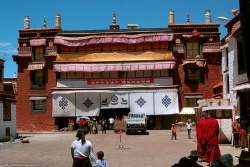Ramoche
The Ramoche Temple (Wyl. ra mo che) in Lhasa was founded by Queen Wencheng at the same time as the Jokhang during the reign of Songtsen Gampo. It originally housed the famous Jowo Rinpoche statue. Later, in response to the threat of an invasion, the Jowo Rinpoche was moved to the Jokhang, where it was originally hidden in a secret chamber. As a replacement, an image of Shakyamuni Buddha known as Jowo Mikyö Dorje, which had been sculpted by the famous craftsman Vishvakarman and brought to Tibet by Queen Bhrikuti, was brought from the Jokhang and installed as the central image in Ramoche.
Ramoche Temple (Tibetan: ར་མོ་ཆེ་དགོན་པ་, Wylie: Ra-mo-che Dgon-pa;昭寺|p=Xiǎozhāosì}}) is a Buddhist monastery is considered the most important temple in Lhasa after the Jokhang Temple. Situated in the northwest of the Tibetan capital of Lhasa, it is east of the Potala and north of the Jokhang, covering a total area of 4,000 square meters (almost one acre).
History
Ramoche is considered to be the sister temple to the Jokhang which was completed about the same time. Tradition says that it was built originally to house the much revered Jowo Rinpoche statue, carried to Lhasa via Lhagang in a wooden cart, brought to Tibet when Princess Wen Cheng came to Lhasa. Unlike, the Jokhang, Ramoche was originally built in Chinese style. During Mangsong Mangtsen's reign (649-676), because of a threat that the Tang Chinese might invade, Princess Wen Cheng is said to have had the statue of Jowo Rinpoche hidden in a secret chamber in the Jokhang. Princess Jincheng, sometime after 710 CE, had it placed in the central chapel of the Jokhang. It was replaced at Ramoche by a statue of Jowo Mikyo Dorje, a small bronze statue of the Buddha when he was eight years old, crafted by Vishvakarman, and brought to Lhasa by the Nepalese queen, Bhrikuti. It is said to have been badly damaged by the Red Guards during the Cultural Revolution.
The temple was badly damaged during the Mongol invasions and there is no certainty that the statue that remained in 1959 was the original one. The original temple was destroyed by fire, and the present three-storied building was constructed in 1474. Soon after it became the Assembly Hall of the Gyuto Tratsang, or Upper Tantric College of Lhasa and was home to 500 monks. There was a close connection with Yerpa which provided summer quarters for the monks
Destruction and restoration
The temple was gutted and partially destroyed in the 1960s and the bronze statue disappeared. In 1983 the lower part of it was said to have been found in a Lhasa rubbish tip, and the upper half in Beijing. for an account of the recovery and restoration. Available online from Cambridge Journals online: Thanks to the efforts of Ri ‘bur sprul sku, the parts were joined in the Ramoche Temple, which was partially restored in 1986,
Following the major restoration of 1986, the main building in the temple now has three stories. The first story includes an atrium, a scripture hall, and a Buddha palace with winding corridors. the second floor is mainly residential but has a chapel with an image of Buddha as King of the Nagas. The third story contained the bedroom and chapel once reserved for Dalai Lama
Upon entering the main building, one can see the ten large fluted pillars holding some of the remaining Tibetan relics such as the encased lotus flowers, coiling cloud, jewelry, and particular Tibetan Characters. The golden peak of the temple with the Han-style upturned eave can be seen from any direction in Lhasa city. The temple is an interesting example of the combination of Han and Tibetan architectural styles.
This temple is one of the key cultural relic protection sites of the Tibet Autonomous Region as well as a popular attraction in Lhasa.
